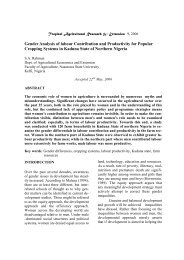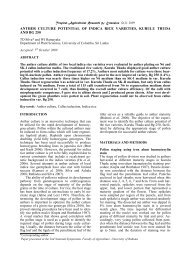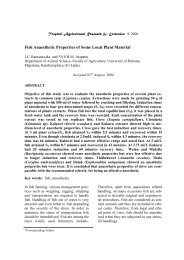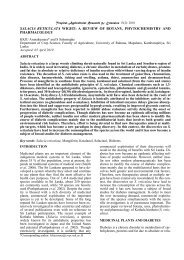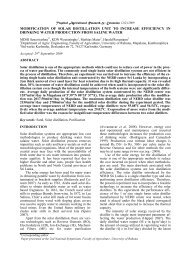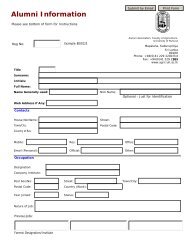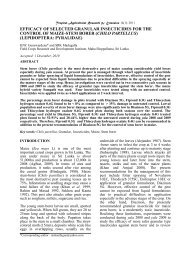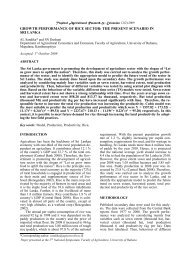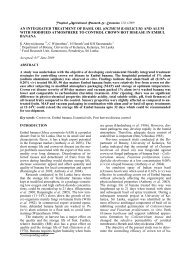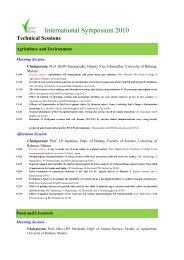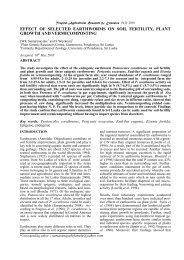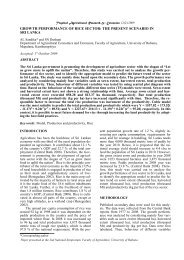Print this article - Sri Lanka Journals Online
Print this article - Sri Lanka Journals Online
Print this article - Sri Lanka Journals Online
Create successful ePaper yourself
Turn your PDF publications into a flip-book with our unique Google optimized e-Paper software.
sustaining the natural resource capital in thesoils; andix. fertilizer use helps reduce global warmingby enhancing sequestration of carbon in theorganic matter of soils, since higher crop yieldsand biomass accumulation obtained throughthe application of fertilizer result in absorptionof more carbon dioxide, a portion of which isheld in soil organic matter (IBSRAM, 1987;Brady, 1993; Chien et al., 1993; Sombroek,1994; Bumb and Baanante, 1996).METHODOLOGYTable 1: Distribution of farmers in Kanoand Katsina States of NigeriaState ADP RelativeclimateKanoKatsinaIIIIIIWetDryDryWetTropical Agricultural Research & Extension 10, 2007Headquarters Total Numberof extension Number of of farmerssevices farmers selectedRano 34,394 60Danbatta 35,032 60Ajiwa 34,543 60Funtua 34,440 6035The study was conducted in two States in theNWZ of Nigeria, namely: Kano and Katsina.These States are considered representative interms of biophysical characteristics and populationdensity for the larger part of northern Nigeria(Ogungbile et al., 1999).In addition, theseStates have a high agricultural production potential(NARP, 1995). The actual survey, however,took place in the Rano and Danbatta AgriculturalDevelopment Programme (ADP)zones of Kano State and the Funtua and AjiwaADP zones of Katsina State. These ADP zoneswere purposively selected with one situated inthe northernmost and driest parts of a State andthe other in the southernmost and wettest parts(Table 1). These ADP zones have also servedas benchmark sites for participatory researchesand for collecting diagnostic data and validatingnew and improved technologies, with theirresults often extrapolated to other areas withsimilar agroecological and socio-economicconditions (Ogungbile et al., 1999). The unitof analysis was the individual farm operator.The frames or lists of the farm operators wereobtained from the monitoring and evaluationunits of each of the four ADP zones (Table 1).For each ADP zone, a sample of sixty farmerswas randomly selected. Thus, a total samplesize of two hundred and forty farmers was obtained.A structured questionnaire was used forthe field interviews. The farm-level data collectedbetween 2002 and 2003 were basicallyon the socio-economic characteristics of thefarm operators, the rates of application, andextent of awareness and adoption of inorganicfertilizer for land conservation.Calculation of inorganic fertilizer adoptionratesThree methods are established in literature forthe calculation of technology adoption rates. Inone method, and where crops are involved, theadoption rate is the ratio of the land area underthe technology of interest to the total area underthe crop in reference, multiplied by 100percent. Studies in <strong>this</strong> category include Akinoand Hayami (1975), Ahmed and Sanders(1991) and Lopez-Pereira et al., ( 1991). Inthese and related studies, adoption rates arecomputed within the broader objective of assessingthe economic impact of research–generated technologies, and under the assumptionthat adoption follows some logistic trendor behaviour (Phillip et al., 2000). This assumptionenables the researcher to project futureadoption rates along a logistic curve, usingobserved adoption rates for some initial yearsof technology introduction (Phillip et al.,2000).A second method refers to adoption as theuse by farmers of a number of improved practicesand is usually measured by an adoptionscore (number of improved practices used) orby an adoption quotient (number of improvedpractices used over total number of recommendedpractices) (Herdt and Capule, 1983).Scores may be arbitrarily scaled to arrive atsome categorization of adoption, for example,low, medium and high (Ramaswamy, 1973).The third method multiplies the ratio ofadopting farmers to the total farmers in thesample by 100 percent (for example, Floyd etal., 999). This method is very popular mainlybecause of its simplicity and is adopted in <strong>this</strong>study in computing adoption rate.Modeling farmers’ decision to adopt inorganicfertilizer for land management purposesThe decision of a farmer to adopt inorganicfertilizer is influenced by a number of different
clined to invest resources in inorganic fertilizer.These results contrast with that of Bhati(1975) who found a positive effect of householdsize on adoption and those of Suh (1976),Yim (1978) and Flinn et al., (1980) who foundno significant impact of household size onadoption. Yim (1978) specifically reported thathousehold size is an insignificant variable infertilizer use. Education was, positively relatedwith adoption in Funtua and Ajiwa Zones aswell as in the pooled result, but was negativelyrelated with adoption in Rano and Danbattazones. A positive coefficient for education impliesthat adoption increases with higher levelof educational attainment. The argument is thathigher education levels are associated withgreater information on conservation measuresand the productivity consequences of land degradation,as well as higher management expertise(Hoover and Wiitala,1980; Ervin and Ervin,1982; Feder et al., 1985). Some studies (Voh,1979; Rogers, 1983; Rahmand Huffman, 1984;Atala, 1984; Kebede et al., 1990; Adesina andSeidi, 1995; Norris and Batie, 1987; Penderand Kerr, 1996; Saito, 2004) have found apositive relationship between education and theadoption of technologies and soil conservationeffort. A negative coefficient for educationimplies that higher education is associated withlower levels of adoption. The reason may bethat higher education provides opportunities toindividuals to acquire knowledge about morelucrative non-farm business opportunities, as aresult of which the adoption of farm-relatedinnovations will lessen. Membership of association’swas, as hypothesized, positively relatedwith adoption in Rano and Ajiwa zones,significantly and positively related with adoptionin Funtua zone as well as in the pooledresult for all the locations, but was negativelyrelated with adoption in Danbatta zone. Apositive sign for the membership of farmers’groups suggests that the longer the membershipof farmers’ groups, the greater the level ofadoption. The membership of associations enhancesaccess to information on improvedtechnologies, material inputs of the technologiessuch as chemical fertilizer, as well ascredit for the purchase of inputs (Njoku, 1990;Akpoko and Yiljep, 2000). Studies elsewhere(Sajise and Ganapin, 1991; Gabunada andBarker, 1995) have found membership in farmers’groups to be positively correlated withadoption. Farm size, consistent with expecta-Tropical Agricultural Research & Extension 10, 200739tions, related with adoption in all the sampledlocations but was significantly related only inAjiwa zone and in the pooled result for thezones. A positive sign for the farm size variableimplies that adoption increases with expansionin farm size. The argument is thatfarm size is often correlated with peasantwealth that may help ease liquidity constraints(Shiferaw and Holden, 1998). Similarly, wealthier farmers are more likely to be able to applyexpensive fertilizer on their farms (Nkonya etal., 1997). Besides, large farmers generatemore income which provides a better capitalbase and enhances risk-bearing ability (Asaduzzaman, 1979; Sarap and Vashist, 1994). Previousresearches (Ervin and Ervin, 1982; Federand Slade, 1984; Norris and Batie, 1987; Gouldet al., 1989; Polson and Spencer, 1991) havealso found a positive role of farm size on conservationdecisions. Credit was posi tively relatedwith adoption of inorganic fertilizeracross the sampled locations except in Danbattazone where no credit was obtained butwas significantly related only in the pooled result.A positive credit coefficient indicates thatthe greater the supply of credit, the higher theadoption. The argument is that the availabilityof credit either in cash or kind enhances farmers’ability to purchase or acquire inorganicfertilizer (Akpoko and Yiljep, 2000). Somestudies (Njoku, 1990; Chikwendu et al., 1993;Agada et al., 1991; Akpoko and Yiljep, 2000)have found credit to be positively associatedwith adoption. Off-farm income was, as expected,positively related with adoption inRano and Ajiwa zones, but was negatively relatedwith adoption in Danbatta and Funtuazones as well as well as in the pooled result. Anegative and significant relationship was, however,observed only in Funtua and in the pooledresult. A positive coefficient for off-farm incomesuggests that the larger the incomeearned from non-farm sources, the greater thelevel of adoption. The argument is that offfarmincome may ease the liquidity constraintneeded for soil-conservation investments orpurchase of fertility-enhancing inputs (Shiferaw and Holden, 1998). A negative coefficientfor off-farm income, on the other hand, impliesthat increases in off-farm income will be accompaniedby reductions in the levels of adoption.The reason is that off-farm investmentmay crowd out investment resources for landqualityimprovement and that increasing de-
40MG MAIANGWA ET AL.: ADOPTION OF CHEMICAL FERTILIZERpendence on non-agricultural activities maytranslate into a shift of interest away fromfarming (Shively, 1997; Shiferaw and Holden,1998). The extension contact variable, as expected,was positively related with adoption inFuntua, Ajiwa (where it was also significantlyrelated) and in the pooled result for the zones,but was negatively related with adoption inRano and Funtua zones. A positive sign for extensioncontact means that adoption increaseswith greater extension contact. Extension contacts,by exposing farmers to availability ofinformation, stimulate adoption (Voh, 1979;Kebede et al., 1990; Polson and Spencer,1991). A negative sign for extension contactshows that the greater the extension contact,the lower the adoption of inorganic fertilizer.This may be because greater access to informationon better non-farm investment opportunitiesfrom more extension contact reduces thelikelihood of investments in farming–relatedtechnologies. The land security variable wasnegatively related with adoption in all the sampledlocations but was significantly and negativelyrelated only in Ajiwa zone and in thepooled result for the locations. A negative coefficientfor the land security variable impliesthat more ownership of land is associated withlower adoption. The reason is that the improvedaccess to credit and liquidity from assuredsecurity of use rights over land makeslow-income households much more inclined toinvest in more profitable non-agricultural venturesthan in farm technologies for soil conservation.CONCLUSION & RECOMMENDATI ONSThe paper investigated the rates of adoptionand application of inorganic fertilizer and thefactors associated with its adoption for landmanagement in the north-west zone of Nigeria.Though adoption rates of inorganic fertilizervaried by location, the calculated rates of adoption(Table 3) are a confirmation of its importanceas a crucial ingredient in the process ofincreasing agricultural productivity. The computedrates of application of inorganic fertilizer(Table 3) are much lower than the recommendedrates of application, thus indicatingthat its yield-and soil-enriching potentials werenot fully realized. All the farmer – and farm –structural characteristics included in our model(Table 5) had positive, negative and in somecases, both positive and negative effects onadoption, thus supporting conclusions reachedin innovation – diffusion and adoption literatureto the effect that farmers’ socio-economiccharacteristics explain technology adoptiondecisions. The following recommendations areimportant:-1. Given that fertilizer requirements for cropswere not and are not likely to be met by farmers,particularly with the reduction, and insome cases phrasing out of fertilizer subsidy,the complementary applications of both inorganicand organic fertilizers will be very useful.Valauwe et al., (2002) reported positiveinteractions between urea and use of stover andother organic applications, while Nhamo(2001) observed added benefits from manureand ammonium intake combinations. Similarly,more appropriate soil and crop managementsystems need to be developed so as to reducethe amount and frequency of application of inorganicfertilizers while also increasing efficiencyof their utilization by crops. The increasingacceptance of integrated soil fertilitymanagement (ISFM) practices by small-holderfarmers need to be encouraged as it expandsthe choice set of farmers by increasing theirawareness of the variety of options availableand how they may complement or substitutefor one another (Place et al., 2003). The ISFMparadigm acknowledges the need for both mineraland organic inputs to sustain soil healthand crop production due to positive interactionsand complementarities between them(Buresh et al., 1997; Vanlauwe et al., 2002).2. Having established that the socio-economicfactors of farmers affect the adoption of inorganicfertilizer, extension educators and technicalassistants involved in agricultural developmentneed to understand these factors inorderto target and deliver effective programmes. Aknowledge of these factors is also necess3. The positive and significant relationship betweenthe education variable and the adoptionof inorganic fertilizer in the results makes theeducation of the rural populace particularlynecessary. Education raises the productivity offarmers in the agricultural production process,increases the rate of return to investments innew production and conservation technologiesand facilitates the adjustment of labour out ofthe agricultural sector. The improvement ofthe literacy skills of farmers and farm workers
Tropical Agricultural Research & Extension 10, 2007alike will allow for proper handling and applicationof inorganic fertilizer.4. The positive and significant relationship betweenthe education variable and the adoptionof inorganic fertilizer in the results makes theeducation of the rural populace particularlynecessary. Education raises the productivity offarmers in the agricultural production process,increases the rate of return to investments innew production and conservation technologiesand facilitates the adjustment of labour out ofthe agricultural sector. The improvement ofthe literacy skills of farmers and farm workersalike will allow for proper handling and applicationof inorganic fertilizer.5. The positive and significant relationship betweenmembership of farmers’ associations andadoption of inorganic fertilizer suggests thatefforts be made to encourage greater andlonger membership of farmers’ groups. Farmers’cooperative associations provide farmerswith many production supplies for their farmoperations such as fertilizers, feed, seeds, farmchemicals; help market products members produce,and also provide services related to theproduction and marketing of farm commoditiessuch as credit, irrigation, pest management, andplant and animal research. It is easier for governmentassistance to reach widely dispersedsmallholders when they organize themselvesproperly into coherent groups such as cooperativesand these also serve as media for widerand cheaper dissemination of information onnew technologies (Njoku, 1990).6. The positive and significant effect of farmsize on adoption of inorganic fertilizer, meansthat expansions in existing farm sizes throughpurchases of additional land, or the consolidationof existing holdings are important. As afactor of production and a store of wealth, landprovides collateral and is one of the fewsources of credit and liquidity for poor farmers.7. The positive and significant influence ofcredit on adoption of inorganic fertilizer makesimproved access to production credit with lowtransaction costs an important requirement.Inorganic fertilizer options are commonly lessaffordable to cash – strapped households thanorganic nutrient systems. The terms of creditshould reflect the fact that much of the returnsto land-conserving practices accrue over a longtime. This is particularly critical because manystudies have found that poor farmers’ inabilityto access mineral fertilizers has adverse consequenceson soil fertility and incomes (Souleand Shepherd, 2000). Thus, credit arrangementsand/or other means of assisting farmersto make necessary capital improvementsshould be designed so that society shares someportion of the cost with farmers, since some ofthe long-term benefits of resource conservationwill also be enjoyed by society (Jayne et al.,1989). The positive and significant effect ofextension contact on adoption of inorganic fertilizeris indicative that extension systems mustbe strengthened to increase farmer knowledgeand understanding of mineral fertilizer sourcesand other related technological options in atimely and accurate manner using the most appropriatecommunication and training methodsand eliciting information about farmers’ concernsand problems with these technologiesand conveying them to research and technologycentres. Collaborating with farmers andresearchers in the development of these technologiesin response to today’s rapidly changingcircumstances would also be extremelyuseful.REFERENCES41Adesina, A.A. and Baidu-Forson, J. (1995)Farmers' perceptions and adoption of newagricultural technology: Evidence fromanalysis in Burkina Faso and Guinea, WestAfrica, Agricultural Economics,13: 1 – 9.Adesina, A.A. and Zinnah, M.M. (1993) Technologycharacteristics, farmers’ perceptionsand adoption decisions: A Tobit model applicationin Sierra Leone, Agricultural Economics,9: 297 – 311.Adesina, A.A. and Seidi, S. (1995) Farmers’perceptions and adoption of new agriculturaltechnology: Analysis of modern mangroverice varieties in Guinea Bissau, Q.J.Int. Agric., 34: 358 – 385.Agada, J.E., Phillip, D. and Musa, R.S. (1997)A logit model for evaluating poultry farmers’participation in the agricultural insurancescheme in Kaduna State, Nigeria, NigerianJournal of Rural Economy and Society,1(3):49 – 55.Ahmed, M.M. and Sanders, J.H. (1991) Theeconomic impacts of Hageen Dura – 1 inthe Gezira scheme, Sudan, Proceedings,International Sorghum and Millet CRSPconference, Corpus Christi, Texas, July 8 –12, 1991.
42MG MAIANGWA ET AL.: ADOPTION OF CHEMICAL FERTILIZERAkino, M. and Hayami, Y. (1975) Efficiencyand equity in public research: Rice breedingin Japan’s economic development,Amer. J. Agr. Econ., 57 (10: 1 – 10.Akpoko, J.G. and Yiljep, Y.D. (2000) Factorsassociated with the adoption of treadlepump technology in the north-west part ofNigeria, Science Forum: Journal of Pureand Applied Sciences, 3(1): 70 – 78.Alao, J.A. (1971) Communication structureand modernization of agriculture: Ananalysis of factors influencing the adoptionof farm practices among Nigerian farmers ,Unpublished Ph.D. thesis,Cornell University,Ithaca, New York.Asaduzzaman, M. (1979) Adoption of HYVrice in Bangladesh, Bangladesh Dev. Stud.,7: 23 – 25.Ashby, J. and Sperking, L. (1992) Institutionalizingparticipatory, client – driven researchand technology development in agriculture,Paper presented at the meeting of theCGIAR social scientists, The Hague, TheNetherlands, September 15 – 22, 1992.Ashby, J.A., Quiros, C.A. and Rivers, Y.M.(1989) Farmer participation in technologydevelopment: Work with crop varieties. InFarmer First: Farmer Innovation and AgriculturalResearch, Intermediate TechnologyPublications, London.Atala, T.K. (1984) The relationship of socioeconomicfactors in agricultural innovationsand utilization of information sourcesin two Nigerian villages, The NigerianJournal of Agricultural Extension, 2 (1 and2): 1 – 10.Atala, T.K. (1988) A study of Factors Relatedto Adoption of Agricultural Innovationsand Level of Living among Maigana andGimba Farmers, Samaru Miscellaneous Paper124, Institute for Agricultural Research,Ahmadu Bello University, Zaria, Nigeria.Atala, T.K. and Abdullah, Y.A. (1988) Adoptionbehaviour of peasant farmers with regardsto improved cropping systems: Acase study of northern Nigeria. In ImprovedAgricultural Technologies for small-scaleNigerian Farmers, G.O.I. Abalu and B.A.Kalu (eds.). Proceedings of the NationalFarming systems Research Network Workshopheld in Jos, Plateau State, Nigeria,May 10-13, 1998.Baidu-Forson, J. (1999) Factors influencingadoption of land-enhancing technology inthe Sahel: Lessons from a case study inNiger, Agricultural Economics, 230: 231 –239.Barbier, E.B. (1998) The Economics of landdegradation and rural poverty linkages inAfrica, United Nations University (UNU)/Institute for Natural Resources in Africa(INRA) annual lectures, public affairs section,The United Nations University, Shibuya-ku,Japan, 1998.Basu, A.C. (1969) The relationship of farmers’characteristics to the adoption of recommendedfarm practices in four villages ofthe Western State of Nigeria, Bulletin ofRural Economics and Sociology, 4(1): 79 –98.Bhati, U.N. (1975) Use of high-yielding ricevariety in Malaysia, The DevelopingEconomies, 13 (2): 187 - 207.Brady, N. (1993) Securing Sustainable AgriculturalDevelopment: The Plant NutrientConnection, IFDC Annual Report 1992,Muscle Shoals, Ala., U.S.A. InternationalFertilizer Development Centre.Bumb,B.L. and Baanante, C.L. (1996) TheRole of Fertilizer in Sustaining Food Securityand Protecting the Environment to2020, Food, Agriculture, and the EnvironmentDiscussion Paper No. 17, InternationalFood Policy Research Institute(IFPRI), Washington, D.C.Buresh, R.J., Sanchez, P.A. and Calhoun. F.(eds.). (1997) Replenishing Soil Fertility,SSA Special publication No. 51, Soil ScienceSociety of America, Madison, Wisconsin,USA.Byerlee, D. and Heisey, P. (1992) Strategiesfor technical change in small-farm agriculture,with particular reference to sub-Saharan Africa. In Policy Options for AgriculturalDevelopment in sub-Saharan Africa,Russel, N.C. and Dowswell(eds.) C.R.Proceedings of a workshop, Airlie House,Virginia, August 23 – 25, 1992.Byrnes, F.C. (1966) Some missing variables indiffusion research and innovation, Paperpresented at the Philippine SociologicalAssociation, Manila, Philippines.Chien, S.H., Carmona, G., Menon, R.G. andHellums, D.T. (1993) Effect of phosphaterock sources on biological nitrogen fixationby soybean, Fertilizer Research, 34: 153 –159.
Chikwendu, D.O., Amos, T.T. and Tologbonse,E.B. (1993) Farmers’ response to agriculturalinsurance in Niger State, Nigeria,Journal of the West African Farming SystemsResearch Network, 5 (2): 45 – 50.Chinnappa, B.N. (1977) Adoption of the newtechnology in North Arcot District. InGreen Revolution Technology and Changein Rice – Growing Areas of Tamil Naduand <strong>Sri</strong> <strong>Lanka</strong>, B.H. Farmer (ed.). Boulder,Colorado, Westview Press.Clark, R.C. and Akinbode, L.A. (1968) FactorsAssociated with Adoption of Three FarmPractices in the Western State of Nigeria,Research Bulletin 1, Faculty of Agriculture,University of Ife, Ile-Ife, Nigeria.Coughenour, C.M. (1960) The functioning offarmers’ characteristics in relation to contactwith media and practice adoption , RuralSociology, 25: 283 – 297.Desai, G.M. (1990) Fertilizer policy issues andsustainable agricultural growth in developingcountries. In Technology Policy forSustainable Agricultural Growth, PolicyBrief No. 7, International Food Policy ResearchInstitute (IFPRI), Washington, D.C.Eicher, C.K. (1994) Building productive nationaland international agricultural researchsystems. In Agriculture, Environment,and Health: Sustainable Developmentin the 21 st Century, V.W. Ruttan (ed.),University of Minnesota Press, Minneapolis,Minnesota.Enwezor, W.O., Udo, E.J., Usoroh, N.J., Ayotade,K.A., Adepetu, J.A., Chude, V.O.and Udegbe, C.I. (eds.). (1989) FertilizerUse and Management Practices for Cropsin Nigeria, Fertilizer Procurement and DistributionDivision, Federal Ministry of Agriculture,Water Resources and Rural Development,Lagos, Nigeria.Ersado, L., Amacher, G. and Alwang, J.(2004) Productivity-and land-enhancingtechnologies in northern Ethiopia: Health,public investments, and sequential adoption,Amer.J.Agr. Econ., 86(2): 321 – 331.Ervin, C.A. and Ervin, D.E. (1982) Factors affectingthe use of soil conservation practices:Hypothesis,evidence and policy implication,Land Economics, 58(3): 272 –292.FAO (Food and Agriculture Ogranization ofthe United Nations). (1997) FAOSTAT StatisticalDatabase 1997, FAO, Rome, Italy.Tropical Agricultural Research & Extension 10, 200743FAO (Food and Agriculture Organization ofthe United Nations). (1993) AgricultureTowards 2010, FAO, Rome, Italy.Feder, G. and Slade, R. (1984) The acquisitionof information and the adoption of newtechnology, Amer. J. Agr. Econ., 66: 312 –320.Feder, G., Just, R. and Zilberman, D. (1985)Adoption of agricultural innovations in developingcountries: A survey, EconomicDevelopment and Cultural Change, 33: 255– 298.Flinn, J.C., Karki, B., Rawal, T., Masicat, P.and Kalirajan. (1980) Rice Production inthe Tarai of Kosi Zone, Nepal, InternationalRice Research Institute Research Paper No.54.Floyd, C.N., Harding, A.H., Paddle, K.C.,Rasali, D.P., Subedi, K.D. and Subedi, P.P.(1999) The adoption and associated impactof technologies in the western hills of Nepal, Overseas Development Institute AgriculturalResearch and Extension NetworkPaper No. 90.Gabunada, F. and Barker, R. (1995) Adoptionof contour hedgerow technology inMataham, Leyte, Philippines , Mimeo.Gould, B.W., W.E. Saupe and R.M. Klemme.1989. Conservation tillage: The role offarm and operator characterstics and theperception of erosion, Land Econ., 65:1657-182.Heisey, P. and Mwangi, W. (1993) An overviewof measuring research impact assessment.In Impacts on Farm Research,Heisey, P. and Waddington, S. (eds.) Proceedingsof a Networkshop on Impacts onFarm Research in Eastern Africa, CIM-MYT Eastern and Southern Africa On-Farm Research Network Paper No. 24, Harare,Zimbabwe.Herdt, R.W. and Capule, C. (1983) AdoptionSpread, and Production Impact of ModernRice Varieties in Asia, International RiceResearch Institute, Los Banos, Laguna,Philippines.Hoover, H. and Wiitala, M. (1980) Operatorand Landlord Participation in Soil Erosionin the Maple Creek Watershed in NortheastNebraska, U.S. Department of Agriculture,Washington, D.C.IBSRAM (International Board for Soil Researchand Management). (1987) Managementof Acid Tropical Soils for Sustainable
44MG MAIANGWA ET AL.: ADOPTION OF CHEMICAL FERTILIZERAgriculture, Proceedings of an IBSRAMinaugural workshop, Bangkok, Thailand.Idisi, P.O. (1990) The potential for hybridmaize production in the northern GuineaSavanna of Nigeria:A comparative studywith the open-pollinated maize varieties,Unpublished M.Sc. thesis, Ahmadu BelloUniversity, Zaria, Nigeria University,Zaria, Nigeria.Islam,M.M. and Halim, A. (1976) Adoption ofIRRI Paddy in a Selected Union of Bangladesh,Bangladesh Agricultural University.Jayne, T.S., Day, J.C. and Dregne, H.E. (1989)Technology and Agricultural Productivityin the Sahel, Agricultural Economic ReportNo. 612, Economic Research Service,United States Department of Agriculture,Washington, D.C.Jigawa Agricultural and Rural DevelopmentAuthority (JARDA). (1996) AgriculturalExtension Manual on Crops, Livestock andFisheries, JARDA.Kebede, Y., Gunjal, K. and Coffin, G. (1990)Adoption of new technologies in Ethiopianagriculture: The case of Tegulet-Bulga district,Shoa Province, Agricultural Economics,4: 27 – 43.Lapar, M.L.A. and Pandey, S. (1999) Adoptionof soil conservation: The case of the Philippineuplands, Agricultural Economics,21: 241 – 256.Lele, U., Christiansen, R.E. and Kadiresan, K.(1989) Fertilizer Policy in Africa: Lessonsfrom Development Programmes and AdjustmentLending, 1970 – 87, MADIA DiscussionPaper No. 5, The World Bank,Washington, D.C.Liao, D.S.N. (1968) Studies on adoption ofnew rice varieties, Paper presented at theIRRI Saturday Seminar, November 1968.Lopez-Pereira, M.A., Gonzalez-Rey, D. andSanders, J.H. (1991) The impacts of newSorghum cultivars and other associatedtechnologies in Honduras, Proceedings ofthe International Sorghum and Millet CRSPConference, Corpus Christi, Texas, July 8–12, 1991.Mangahas, M. (1970) An economic analysis ofthe diffusion of new rice varieties in centralLuzon, Unpublished Ph.D. dissertation,University of Chicago.Mitchell, D.O. and Ingco, M.D. (1993) TheWorld Food Outlook, The World Bank,Washington, D.C.Musa, M.W. ands Atala, T.K. (2004) Complementaryuse of indigenous and moderntechnical knowledge as best practices forsustainable agricultural development: Acase study. In Indigenous Knowledge andsustainable Agricultural Development inNigeria, C.P.O. Obinne, B.A. Kalu and J.C.Umeh (eds.), Proceedings of the NationalConference on Indigenous knowledge andDevelopment, Cekard Associates, 2004.National Agricultural Research Project. (1995)Draft Report of the National AgriculturalResearch Strategy Plan: Volume 1, FederalDepartment of Agriculture and Natural Resources,Lagos, Nigeria.Nhamo, N. (2001) An evaluation of the efficacyof organic and inorganic fertilizercombinations in supplying nitrogen tocrops , Unpublished M.Phil. Thesis, Universityof Zimbabwe, Harare, Zimbabwe.Njoku, J.E. (1990) Factors influencing theadoption of improved oil palm productiontechnologies by smallholders in Imo Stateof Nigeria. In Appropriate AgriculturalTechnologies for Resource–Poor Farmers,Olukosi,, J.O. Ogungbile, A.O. and Kalu,B.A. (eds.), Proceedings of the NationalFarming systems Research Network Workshopheld in Calabar, Cross-River State,Nigeria, August 14 – 16, 1990.Nkonya, E., Schroeder, T. and Norman, D.(1997) Factors affecting adoption of improvedMaize seed and fertilizer in NorthernTanzania, Journal of Agricultural Economics,48(1):13–21.Norris, P.E. and Batie, S.S. (1987) Virginiafarmers’ soil conservation decisions:Anapplication of Tobit analysis, South. J. Agric.Econ., 19:79– 89.Nowak, P.J. (1987) The adoption of agriculturalconservation technologies: Economicand diffusion explanations,’ Rural Sociol.,52: 208 – 220.Ogungbile, A.O., Tabo, R. and van Duivenbooden,N. (1999) Multi-scale Characterizationof Production Systems to PrioritizeResearch and Development in the SudanSavanna Zone of Nigeria, Information BulletinNo. 56, International Crops ResearchInstitute for Semi-Arid Tropics (ICRISAT),Patancheru, Andhra Pradesh, India.Omiti,J.M., Freeman, H.A., Kaguongo, W.and Bett., C. (1999) Soil Fertility Maintenancein Eastern Kenya:Current practices,
Constraints, and Opportunities, CARMA-SAK Working Paper No.1, KAR/ICRISAT,Kenya.Onwueme, I.C. and Sinha, T.D. (1991) FieldCrop Production in Tropical Africa: Principlesand Practice, Technical Centre forAgricultural and Rural CooperationPander, J. and Kerr, J. (1996) Determinants ofFarmers’ Indigenous Soil and WaterConservation Investments in India’s Semi-Arid Tropics, EPTD Discussion Paper No.17, International Food Policy ResearchInstitute (IFPRI), Washington, D.C.,Phillip, D., Maiangwa, M. and Phillip, B.(2000) Adoption of Maize and related technologiesin the north-west zone of Nigeria ,Moor Journal of Agricultural Research, 1:98 – 105.Pinstrup–Andersen, P. and Pandya-lorch, R.(1994) Alleviating Poverty, IntensifyingAgriculture, and Effectively ManagingNatural Resources, Food, Agriculture, andthe Environment Discussion Paper No. 1,International Food Policy Research Institute,Washington, D.C.Place, F., Barrett, C.B., Ade Freeman, H.,Ramisch, J. and Vanlauwe, B. (2003) Prospects for integrated soil fertility managementusing organic and inorganic inputs:Evidence from smallholder African agriculturalsystems, Food Policy 28: 365 – 378.Polson R.A. and Spenser, D.S.C. (1990) Thetechnology adoption process in subsistenceagriculture: The case of cassava in southwesternNigeria, Agricultural Systems, 36(1): 65 – 78.Rahm, M. and Huffman, W. (1984) The adoptionof reduced tillage: The role of humancapital and other variables. Amer. J. Agr.Econ., 66: 405 – 413.Ramswamy, D. 1993. Adoption incentives relatedto packages of practices of highyieldingvarieties in Mysore State, India,Unpublished Ph.D. thesis, Cornell University,Ithaca, New York.Ranaivoarison, R. (2004) Land property rightsand agricultural development in the highlandsof Madagascar: Economic and environmentalimplications. In Farming andRural systems Economics, W. Doppler andS. Bauer (eds.). Margraf Publishers.Reardon, T., Barrett, C.B., Kelly, V. and Savadogo,K. (1999) Sustainable versus unsustainableagricultural intensification in Af-Tropical Agricultural Research & Extension 10, 200745rica: Focus on policy reforms and marketconditions, In Agricultural Intensification,Economic Development and the Environment,Forthcoming.Rogers, E.M. (1983) Diffusion of Innovations,John Wiley and Sons, New York.Rogers, E.M. and Burdge, R.J. (1977) Communitynorms, opinion leadership and innovativenessamong truck growers, Ohio AgriculturalExperiment Station Research Bulletin.37: 1 – 5.Rosegrant, M.W., Agcaali–Sombilla, M. andPerez, N.D. (1995) Global Food Projectionsto 2020: Implications for investment,Food, Agriculture, and the EnvironmentDiscussion Paper No. 5, International FoodPolicy Research Institute, Washington,D.C.Saito, K. (1994) Raising the Productivity ofWomen Farmers in sub-Saharan Africa,Discussion Paper No.203, The WorldBank, Washington, D.C.Sajise, P. and Gawapin, D. (1991) An overviewof upland development in the Philippines. In Technologies for SustainableAgriculture on Marginal Uplands in SoutheastAsia, G. Blair and R. Lefroy (eds.),ACIAR Proceedings No. 33, AustralianCentre for International Research.Sarap, K. and Vashist, D.C. (1994) Adoption ofmodern varieties of rice in Orissa: A farmlevelanalysis. India J. Agric. Econ., 49: 88– 93.Shiferaw, B. and Holden, S.T. (1998) Resourcedegradation and adoption of land conservationtechnologies in the Ethiopian highlands:A case study in Andit Tid, NorthShewa, Agricultural Economics, 18: 238–247.Shively, G.E. (1997) Consumption risk, farmcharacteristics and soil conservation adoptionamong low-income farmers in the Philippines,Agricultural Economics, 17: 165–177.Sombroek, W.G. (1994) Aspects of Soil organicmatter and nutrient cycling in relationto climate change and agricultural sustainability, Paper presented at the InternationalSymposium on Nuclear and Related Techniquesin Soil/Plant Studies on SustainableAgriculture and Environmental Preservation,held jointly by the InternationalAtomic Energy Agency and the Food andAgriculture Organization of the United Nations,Vienna, Austria.
46MG MAIANGWA ET AL.: ADOPTION OF CHEMICAL FERTILIZERSoule, M. and Shepherd, K.D. (2000) An ecologicaland economic analysis of phosphorusreplenishment for Vihiga Division,western Kenya , Agricultural Systems, 64:83 – 98.Vanlauwe, B., Diels, J., Sanginga, N. andMerckx, R. (2002) Integrated Plant NutrientManagement in Sub-Saharan Africa:From concept to Practice, CABI, Wallingford,U.K.Voh, J.P. (1979) An Exploratory Study ofFactors Associated with Adoption of RecommendedFarm Practices Among GiwaFarmers, Samaru Miscellaneous PaperNo.73, Institute for Agricultural Research,Ahmadu Bello University, Zaria, Nigeria.World Bank. (1986) Internal Memorandum.July 17, 1986.Yim, K.M. (1978) An economic analysis offactors affecting HYV and fertilizer adoptionin the province of Negeri Sembilan,Peninsular Malaysia , Unpublished M.Sc.thesis, University of the Philippines, LosBanos, Philippines.Zurek, M.B. (2002) Induced innovation andproductivity - enhancing, resourceconservingtechnologies in Central America:The supply of soil conservation practicesand small-scale farmers’ adoption inGuatemala and El Salvador , UnpublishedPh.D. thesis, Justus-Liebig University,Giessen, Germany.



